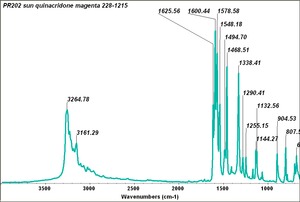Quinacridone dye
Jump to navigation
Jump to search
Description
A series of synthetic red and violet dyes composed of linear quinacridones that are made from terephthalic acid. Quinacridone dyes can exist in four crystalline allotropes, two of which are sold as red and violet pigments. Although synthesized in 1896, quinacridone colors were first recognized as useful pigments by W. Struve at DuPont in 1955 and marketed in 1958 under the name Monastral. These lightfast colorants are used in paints, printing inks, and plastics.
Synonyms and Related Terms
colorante de quinacridona (Esp.)
Examples include:
- Red - Monastral red [DuPont]; Acra red [Liquitex]; Acra crimson [Binney and Smith]; Bocour red [Bocour Artist Colors];Thalo Red Rose
- Violet - Monastral violet, Pigment Violet 19; CI 46500;
Comparisons
| Pigment number | Manufacture | Pigment name | Manufacture CI number | Comments | |
|---|---|---|---|---|---|
| PV019 | Kremer | unspecified | 23700 | ||
| PV019 | Kremer | unspecified | 23710 | same as PV019 Sun quinacradone violet 228-1119 | |
| PV019 | Sun | quinacradone red | 228-0022 | ||
| PV019 | Sun | quinacradone violet | 228-1119 | same as PV019 Kremer 23710 | |
| PR122 | Sun | quinacradone magenta | 228-0013 | same as PR122 Kremer 23152 | |
| PV122 | Kremer | unspecified | 23152 | same as PR122 Sun 228-0013 | |
| PR202 | Sun | quinacradone magenta | 228-1215 | ||
| PR202 | unknown | cinquasia magenta RT-343-D | unknown | from Tate Collection | |
| PR209 | unknown | hostaperm red EG transparent (quinacradone) | unknown | spectrum does not match Tate PR209 | |
| PR209 | unknown | hostaperm red EG transparent (quinacradone) | sample from the Tate Collection | spectrum does not match other PR209 |
Physical and Chemical Properties
Resistant to alkalis and heat.
| Composition | violet- C20H12N2O2 |
|---|---|
| Density | 1.5 g/ml |
| Refractive Index | 2.02 - 2.04 |
Resources and Citations
- R. J. Gettens, G.L. Stout, Painting Materials, A Short Encyclopaedia, Dover Publications, New York, 1966
- G.S.Brady, Materials Handbook, McGraw-Hill Book Co., New York, 1971 Comment: p. 611
- Reed Kay, The Painter's Guide To Studio Methods and Materials, Prentice-Hall, Inc., Englewood Cliffs, NJ, 1983
- Ralph Mayer, A Dictionary of Art Terms and Techniques, Harper and Row Publishers, New York, 1969 (also 1945 printing)
- Richard S. Lewis, Hawley's Condensed Chemical Dictionary, Van Nostrand Reinhold, New York, 10th ed., 1993
- Hermann Kuhn, Conservation and Restoration of Works of Art and Antiquities, Butterworths, London, 1986
- Monona Rossol, The Artist's Complete Health and Safety Guide, Allworth Press, New York, 1994
- Encyclopedia Britannica, http://www.britannica.com Comment: "chemical compound." Accessed 7 Apr. 2005 .
- Art and Architecture Thesaurus Online, https://www.getty.edu/research/tools/vocabulary/aat/, J. Paul Getty Trust, Los Angeles, 2000
- Website: www.handprint.com





